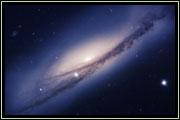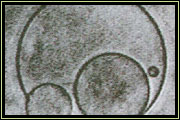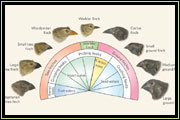"Tour 5 - Science: What is True?"
Fact Check

Fact Check: "By keeping the details of creation's story completely inside 'the box,' evolution effectively rules out the existence of God."
(This claim is made at the beginning of tour 5's lesson guide.)
First, "By keeping the details of creation's story completely inside 'the box,' evolution..."
Evolution does not keep the details of Creation's story completely inside the box. Biological evolution does not account for how the first life form appeared, let alone how the entire universe came into being. Evolution comments only on how life on Earth diversified.
Verdict: False.
And now the second part, "... evolution effectively rules out the existence of God."
 A small child is cured of a fatal disease using experimental medicine. By keeping the details of how the medicine worked completely inside 'the box,' does this effectively rule out the existence of God?
An acorn grows into a sapling, which grows into a gigantic oak tree. By keeping the details of the mechanisms by which the tree grew inside 'the box,' does this effectively rule out the existence of God?
Step inside a damp, ancient cave and you'll likely find stalactites, draperies, stalagmites, columns and flowstone. By keeping the details of how these formations came about inside 'the box,' does this effectively rule out the existence of God?
The answer, I hope you'd agree, is "no" to all three. Describing the mechanics of God's creation never rules out the existence of God, whether you incorporate God into your descriptions or not. The reason why scientists are methodologically naturalistic is because it's imprudent to invoke God's intervention as an explanation when such miraculous intervention may not be necessary.
And how do you determine whether God's miraculous intervention was necessary for some observation? By assuming, for the sake of argument, that God did not intervene and attempting to find a sufficient natural explanation.
That's methodological naturalism. It's prudent, responsible, and reasonable. Many folks recognize that methodological naturalism is useful; some of these folks, unfortunately, then conclude that metaphysical naturalism, a philosophical position that denies the supernatural completely, is true. As Christians, we instead conclude that much of God's plan flows naturally through His creation without intervening at every moment with miraculous "exceptions."
(We believe that God does, occasionally, make such exceptions. But His creation does not depend at every instant upon miraculous exceptions to physically keep it working as intended. God was smarter than that when He created our amazing, procedural, self-propagating universe.)
Scientific theories never rule out God's existence merely by keeping their details, appropriately, in the natural realm. It is only the hyper-applied, "science" (so-called) of metaphysical naturalists that takes issue with God.
Verdict: False.


Fact Check: The Second Law of Thermodynamics contradicts Carl Sagan's proposal that the cosmos has always existed.
Carl Sagan's proposal is not that matter and energy have always existed, as if the current composition of the universe in its material and energetic state have been floating around for an infinitely long time. His proposal was that about 13 billion years ago there was a "Big Bang," which from a singularity generated all of the matter and energy we see today. He further proposed that this singularity could be the result of a complete collapse of an antecedent universe. So his proposal was that the universe oscillates from explosion to implosion, each time reinitializing the material and energetic soup and "rebooting" its entropic state.
Whether or not this is true (as Christians, of course, we believe that God instantiated the universe), his proposal does not necessarily contradict the Second Law of Thermodynamics because it "reboots" universal entropy.
Verdict: False.
Following his appeal to the Second Law of Thermodynamics, Del Tackett says, "Don't believe that we stand on some whimsical notion of faith!"
So-called "God-proofs" from science are seldom ever cogent and they undermine the undeniable reason to believe: the saving faith produced by a person's interaction with God himself. It's not whimsical (it's serious and efficacious) and it's not scientific (it's supernatural and, often, not publicly expressable). It is, in fact, the core of the individual's Christian experience.


Fact Check: "[We see] order instead of chaos."
We see both order and chaos. Chaos is the unpredictability of a system due to that system's complexity (rather than due to actual randomness within the system). The weather, for instance, is chaotic, because there's no way we can track every air and water molecule around the world. Thus we have to abstract weather into patterns like "storms," "jet streams," "low pressure fronts," etc. Even though we've come up with useful patterns, we're still only able to reliably forecast the weather for a few days at most because the system is still quite chaotic and eludes our full mental grasp.
This is not to say that the system is completely without order. Underlying all chaos is the orderly behavior of its subcomponents. As Christians, we believe that God is responsible for the fundamental order that produces all the proximal orderliness and chaos that we see.
Since chaos is unpredictability due to complexity, chaos is relative to the observer's ability to figure out what's happening. Many things are chaotic to us, like weather or dice rolls or the net sum of governmental activity. Since God is omniscient, nothing is chaotic to Him.
Verdict: False; we see both.


Fact Check: As a result of Louis Pasteur's meat experiments, "spontaneous generation has broken down."
Louis Pasteur successfully showed that meat does not spontaneously generate flies. In retrospect, the notion that flies can be spontaneously generated from meat is clearly ridiculous.
Cells arising from simpler persistent, similarly-shielded organic machines is, on the other hand, plausible. These simpler machines are called "protobionts." They are organic molecules bounded by membrane-like structures -- not yet cells, but cell-like, even to the point of having liposomes and microspheres similar to cells' phospholipid bilayers. These protobionts have been found to reproduce, metabolize, react to stimuli, and maintain their constitution versus their environment. In other words, they are functionally "alive."
The fascinating part is that protobionts can form spontaneously from various chemical "soups," as demonstrated by experiments performed by Sidney W. Fox and Aleksandr Oparin. And these chemical recipes are the same as thought to have existed upon primordeal, ancient Earth.
Verdict: False.


Fact Check: The mousetrap is irreducibly complex.
Irreducible complexity is the cornerstone of those who believe that natural abiogenesis is impossible, and thus required a miracle. In "Darwin's Black Box," author Michael Behe makes an analogy to a mousetrap. He says that if you eliminate a component of the moustrap, it stops being functional, and that we see this irreducible complexity in bacterial flagella and the process of blood clotting.
Although the mousetrap is a mere analogy, we can successfully hijack the analogy to make a point about how reducibility is sometimes not so obvious. The baseplate, for instance, can be removed and the rest of the mechanism could instead be bolted to the floor. The pressplate could be removed, and the new device would depend on being jostled into action.
Additionally, you could use a reduced mousetrap as something else -- a tie clip is the example Miller often uses. All evolution cares about is persistence, so as long someone has a reason to keep the partially-distmantled mousetrap around (in this case, to clip his tie), it qualifies as functional.
This is just an analogy, but it correlates to recent scientific findings related to blood clotting processes and bacterial flagella. They are, as it turns out, reducibly complex.
It's important to note that when Behe himself is confronted with the reduced mousetrap or the scientific findings during debates, he backpedals to "unconstructable complexity" rather than "irreducible complexity."
Verdict: False.


Fact Check: The changes that Darwin's finches undergo over time oscillate.
This is based on a claim made in Chapter 8 of Johnathan Wells' book, "Icons of Evolution," which Del references frequently in this tour. Wells noted that we have observed hybridization in the finches in which the resultant hybrids, or the "new stock," were more fit than the "old stock." He makes the following argument:
- Because the selective environment (the climate, the food sources, etc.) oscillates,
- and because fit hybrids of various kinds of finches are produced,
- thus the evolutionary direction of the finches is not toward divergence (a greater and greater variety of finch species), but toward some oscillating pattern.
There are two problems with this argument: it is moot, and it is false. It is moot because evolutionary theory doesn't mandate divergence in all cases. It is false because these hybrids are rare, have not been observed outside of the island Daphne Major, and don't mate with one another -- the hybrids mate with their "old stock" companions rather than others of the "new stock."
So "B" is a vast overstatement. It implies that finch hybrids are happening frequently and mate with one another, neither of which is the case. So while we can expect to see morphological (how they look) oscillation, genetic and compatibility oscillation remain unreasonable conclusions.
Verdict: Misleading. Morphological changes may oscillate, but genetic changes and changes in compatibility probably do not. The finches remain an excellent example of macroevolution in progress.


Fact Check: There are no transitional fossils; "We're worse off than we were [in Darwin's time]."
This is absurdly untrue. It is so untrue that it's hard to come up with words to describe how untrue it is. It's so untrue that claiming it betrays either ignorance (lack of information) or deceit (purposeful misrepresentation).
To be fair, Del was using an article from 1979, and many of the more striking examples of transitional fossils have been documented over the last 30 years.
For example, the protozoan Globigerinoides trilobus evolved into the Orbulina universa, and we have a gradual fossil sequence that proves it. (Pearson 1997)
Then there's the algae genus called Rhizosolenia. Their fossils are common. Through these fossils we have a continuous record of evolution over the course of two million years, and in that record we even see a speciation event (macroevolution). (Miller 1999)
And that's just the tip of the iceberg.
We have fossils of other trilobites (Eldredge 1972; 1974; Strapple 1978), scallops (Pojeta and Springer 2001; Ward and Blackwelder 1975), molluscs (Lewin 1981), ostracodes (Cronin 1985), oysters (Hallam 1968), snakes (Tchernov 2000; Caldwell and Lee 1997), bees (Poinar and Danforth 2006), seed plants (Gerrienne 2004), manatees (Domning 2001) and whales (Gingerich, Thewissen, Hussain, Stricherz, mostly 1990s; their ancestors were land mammals!) and even primates that show gradual evolutionary transitions (Gingerich 1976, 1980, 1983).
As with all history, there's some degree of speculation. But there's a greater degree of reasonable certainty when enough of the apparent transitions have been filled in, and that's what has happened with these incredibly numerous, thoroughly studied fossils.
This is the primary reason why evolutionary theory is so broadly accepted: the fossil record endorses it, despite Del's untrue claim.
Verdict: False.
- Caldwell, M. W. and M. S. Y. Lee, 1997. A snake with legs from the marine Cretaceous of the Middle East. Nature 386: 705-709.
- Cronin, T. M., 1985. Speciation and stasis in marine ostracoda: climatic modulation of evolution. Science 227: 60-63.
- Domning, Daryl P., 2001. The earliest known fully quadupedal sirenian. Nature 413: 625-627.
- Domning, Daryl P., 2001. New "intermediate form" ties seacows firmly to land. Reports of the National Center for Science Education 21(5-6): 38-42.
- Eldredge, Niles, 1972. Systematics and evolution of Phacops rana (Green, 1832) and Phacops iowensis Delo, 1935 (Trilobita) from the Middle Devonian of North America. Bulletin of the American Museum of Natural History 147(2): 45-114.
- Eldredge, Niles, 1974. Stability, diversity, and speciation in Paleozoic epeiric seas. Journal of Paleontology 48(3): 540-548.
- Gerrienne, P. et al. 2004. Runcaria, a Middle Devonian seed plant precursor. Science 306: 856-858.
- Gingerich, P. D., 1976. Paleontology and phylogeny: Patterns of evolution of the species level in early Tertiary mammals. American Journal of Science 276(1): 1-28.
- Gingerich, P. D., 1980. Evolutionary patterns in early Cenozoic mammals. Annual Review of Earth and Planetary Sciences 8: 407-424.
- Gingerich, P. D., 1983. Evidence for evolution from the vertebrate fossil record. Journal of Geological Education 31: 140-144.
- Gingerich, P. D. et al., 1983. Origin of whales in epicontinental remnant seas: New evidence from the Early Eocene of Pakistan. Science 220: 403-406.
- Gingerich, P. D., B. H. Smith, and E. L. Simons, 1990. Hind limb of Eocene Basilosaurus: Evidence of feet in whales. Science 249: 154-157.
- Gingerich, P. D. et al., 1993. Partial skeletons of Indocetus ramani [Mammalia, Cetacea] from the Lower Middle Eocene Domanda Shale in the Sulaiman Range of Punjab [Pakistan]. Contributions from the Museum of Paleontology of the University of Michigan 28: 393-416.
- Gingerich, P. D. et al., 1994. New whale from the Eocene of Pakistan and the origin of cetacean swimming. Nature 368: 844-847.
- Gingerich, P. D. et al. 2001. Origin of whales from early artiodactyls: Hands and feet of Eocene Protocetidae from Pakistan. Science 293: 2239-2242.
- Hallam, A., 1968. Morphology, palaeoecology and evolution of the genus Gryphaea in the British Lias. Philosophical Transactions of the Royal Society of London B 254: 91-128.
- Lee, Michael S. Y., Gorden L. Bell Jr. and Michael W. Caldwell, 1999. The origin of snake feeding. Nature 400: 655-659.
- Lewin, R., 1981. No gap here in the fossil record. Science 214: 645-646.
- Miller, Kenneth R., 1999. Finding Darwin's God. New York: HarperCollins.
- Pearson, P. N., N. J. Shackleton and M. A. Hall. 1997. Stable isotopic evidence for the sympatric divergence of Globigerinoides trilobus and Orbulina universa (planktonic foraminifera). Journal of the Geological Society, London 154: 295-302.
- Poinar, G. O. Jr. and B. N. Danforth. 2006. A fossil bee from Early Cretaceous Burmese amber. Science 314: 614.
- Strapple, R. R., 1978. Tracing three trilobites. Earth Science 31(4): 149-152.
- Stricherz, Vince, 1998 (10 Oct.). Burke displays fossil of toothless whale.
- Tchernov, E. et al., 2000. A fossil snake with limbs. Science 287: 2010-2012.
- Thewissen, J. G. M. and S. T. Hussain, 1993. Origin of underwater hearing in whales. Nature 361: 444-445.
- Thewissen, J. G. M., S. T. Hussain and M. Arif, 1994. Fossil evidence for the origin of aquatic locomotion in archaeocete whales. Science 263: 210-212.
- Ward, L. W. and B. W. Blackwelder, 1975. Chesapecten, A new genus of Pectinidae (Mollusca: Bivalvia) from the Miocene and Pliocene of eastern North America. U.S. Geological Survey Professional Paper 861.

(c) 2009 The Truth Problem.
|